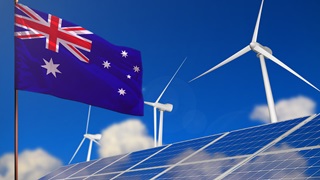
Publication
Supply chains perspective
In the fight against climate change and other sustainability concerns, challenges faced by companies in navigating their supply chain woes cannot be ignored.


Auteur:
Australie | Publication | February 2023
With the announcement of the Queensland Energy and Jobs Plan (QEJP) and Queensland SuperGrid Infrastructure Blueprint (QSIB) on 28 September 2022, there has been a buzz about the magnitude of the opportunity for developers, investors, financers and the State – and the bold ambition expressed by our heavily coal and gas dependent State.
In this short analysis, we consider some of the key elements of the plan, and the opportunities and challenges. These are relevant not only for Queensland, but Australia as a whole, and indeed the world, as we navigate the energy transition.
Without restating the Overview, the headline numbers in the QEJP are:
These ambitious targets would be achieved by deploying $62 billion in investment from this year, for an aggregate of 25GW of wind and solar generation plus related transmission and storage infrastructure – including the development of two long duration pumped hydro energy systems (Borumba and Pioneer-Burdekin).
Specific actions across three pillars – having a clean energy economy; empowering households and businesses; and securing jobs and communities –bring an integrated vision to how these targets can be realised, while ensuring secure, affordable and sustainable energy generation for the future. For example, there are commitments to invest in electric vehicle charging infrastructure, energy efficiency initiatives, employment training, greening gas fired generation (with the introduction of green hydrogen) and repurposing of the existing coal fleet and sites.
There are many ways to deliver these targets. Beyond a clear plan for enabling grid infrastructure and system services, there is scope within the QEJP and QSIB for many private proponents to continue to develop their projects in the ordinary course, with those viable projects proceeding when commercially ready.
Governance arrangements (including an Advisory Board and Industry Council) will monitor the implementation of the QEJP and progress against its targets. The QEJP and QSIB will be routinely revisited and updated to reflect the changing market and forecasts.
The QEJP vision promises ‘clean, reliable and affordable energy’ – covering all aspects of the oft-cited energy trilemma, but doesn’t have the same ‘front and centre’ focus on the less often commented on fourth limb: Energy justice.
For completeness, the QEJP is not entirely silent on the social aspects of the energy system. Policies that go to affordability are cognisant of the need for electricity to be affordable for everyone. There are promises of household savings programs to lower electricity bills, creating a program to focus on energy efficiency and cost savings measures for households and small businesses, and extending the Uniform Tariff policy to ensure reasonably priced electricity extends across the entire State.
The jobs focussed actions are intended to ensure continued and expanded employment opportunities for regional Queensland, First Nations and reskilling existing workforces for the infrastructure and opportunities that flow from the QEJP.
With a growing focus on Environmental, Social and Governance (ESG) responsibilities across all elements of project delivery, we would expect the social aspect of the QJEP will also be in focus as the QEJP is delivered by the public and private sectors. ESG overlays will be applied.
Some of the key questions are:
Hidden within these questions are incredible opportunities for Queensland to lead the way in conceptualising and operationalising energy justice and the wholesale decarbonisation of our energy system.
Applying a macroeconomic lens, climate change is a global issue and responses to the challenges of climate change are being progressed (almost) universally and simultaneously. Naturally, this creates significant demand for a limited supply of clean energy technology, skilled labour and capital. We have global supply chains disrupted by COVID and reliant on carbon intensive freight.
Beyond this, there is war in the Ukraine (and global instability generally), oil and gas markets impacted by sanctions and concerns about the increasing influence of China in Asia Pacific.
Australia has sought to take protectionist measures to ensure its domestic gas supply. As has been the case for millennia, national interest will often overcome longer term thinking. There is a risk that we may lose or find ourselves with restricted access to imported components – batteries, solar panels, wind turbines, trackers, inverters, synchronous condensers, cable, steel and other inputs – that are essential to deliver the many infrastructure assets necessary to deliver this version (or they take longer or cost much more than forecast). Bilateral and multilateral trade agreements and supporting commitments and documents will be important to securing the imports that are essential.
Off the back of the QEJP, and cognisant of these supply risks, Queensland has already launched an Expression of Interest for onshoring the manufacture of these crucial components for renewable energy generation and storage. With this, Queensland is one step closer to being a renewable energy superpower to not only export power, but components, to the world.
At a more local level, Australia currently has insufficient contracting and labour capacity to deliver the large number of projects being proposed and developed in parallel across the country (and into our oceans!).
In some cases, there is limited track record in delivering the types of projects that will need to be delivered in the near term or disappointing recent experience (with delay, cost escalations further aggregating other base case concerns such as curtailment and market disruption). These concentration and delivery risks will not sit well with the limited recourse debt market that many project proponents will seek to access to convert their projects into reality.
We have record low unemployment (which translates to labour shortages and wage pressure), an affordable accommodation crisis and limited numbers of migration visas with higher international travel costs (plus, when we start counting it, the related carbon cost). All of these factors will put upward pressure on project costs, upward pressure on revenue demands for viability and risks more expensive energy (in the short term) when compared to a non-carbon cost adjusted baseline.
Nationally, the Australian Energy Market Operator continues to publish its Integrated System Plan as it seeks to coordinate a coherent plan for the NEM, yet the States are off running their own race, while developers struggle to finalise connections, negotiate performance standards and offtake arrangements in a shifting regulatory environment and dynamic electricity market.
Queensland remains a proud owner of its critical infrastructure, and there is no sign of change in the Plans – in fact, State ownership is reinforced as a preferred model. Historically, the State has shied away from operating leases and long term concessions in the electricity sector due to their concern they may be seen as privatisations of energy assets (whether generation or distribution). While this approach has held the State in good stead, and gives it unique leverage that States with greater private ownership do not enjoy, that significant investment will be required, both by the State and the private sector, to deliver the capital components of the SuperGrid.
We have already seen some flexibility in approach, however, with Powerlink accepting debt from the CEFC for transmission infrastructure in the Southern REZ – taking some of the costs away from projects yet to be connected and away from State sourced funding thorugh the Treasury and Queensland Treasury Corporation. It is clear that the State is listening to how it can best deploy the limited funds it has available to unlock as much of the SuperGrid as possible and increase confidence for private sector expenditure.
There will be opportunities for new financing approaches and shifting risk allocations and approaches, especially as foreign investors and banks import their credit approach and lessons learned from other jurisdictions.
The current papers are the beginning of an ongoing conversation. Community consultation will begin later this year, with a variety of supporting policies, roadmaps and strategies to follow in 2023.
In engaging with the QEJP (or any energy policy), there will never be a perfect model – be it at State, national or global level – and waiting for one risks inertia (and frustration). Instead, we expect stakeholders will continue to deal with imperfection, putting one foot forward to capitalise on the opportunities that abound, building their credentials, carving out their space and pocketing lessons and returns in the process.
All of these challenges bring with them opportunities for innovation. The QJEP, and the energy transition more broadly, requires optimism, creativity and commercial pragmatism.

Publication
In the fight against climate change and other sustainability concerns, challenges faced by companies in navigating their supply chain woes cannot be ignored.

Publication
The Australian Energy Market Commission (AEMC) has recently recommended changes to the national gas and energy retail rules in order to facilitate the incorporation of hydrogen and renewable gases into the Australian market.

Publication
The global spotlight is on Australia. We identify why, how and the opportunities that it presents right now.

Publication
Le 8 avril dernier, le ministre des Finances du Québec, Eric Girard, a présenté à l’Assemblée nationale le projet de loi n° 92, Loi modifiant diverses dispositions principalement dans le secteur financier (projet de loi 92), qui fait suite au dernier omnibus financier sanctionné le 9 mai dernier et s’inscrit dans la lignée des projets de loi omnibus à caractère financier qu’il a présentés en vue de moderniser le cadre réglementaire applicable au secteur financier québécois.

Publication
Le 23 mars 2025, le premier ministre du Canada, Mark Carney, a déclenché des élections fédérales qui se tiendront le 28 avril prochain.

Publication
Le 27 mars dernier, l’Autorité des marchés financiers (AMF) a publié des projets de modification (modifications) dans une publication intitulée « Règlement modifiant le Règlement 81-102 sur les fonds d’investissement » concernant les cryptoactifs.
Abonnez-vous et restez à l’affût des nouvelles juridiques, informations et événements les plus récents...
© Norton Rose Fulbright LLP 2025